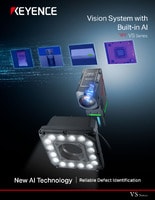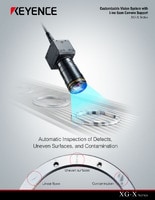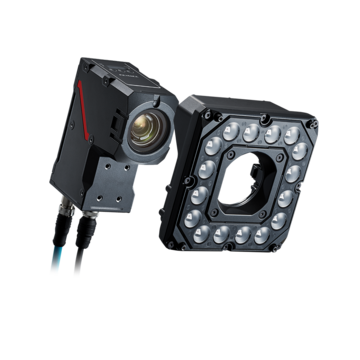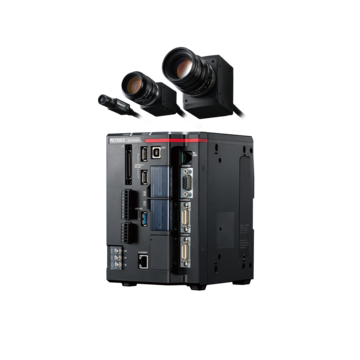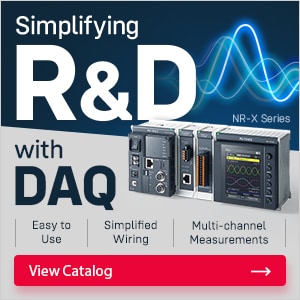Vision Systems
- Vision System with Built-in AI VS series
- Intuitive Vision System CV-X series
- Customizable Vision System XG-X series
- GigE camera and lighting for PC-based machine vision VJ series
- Inline 3D Inspection 3D Vision series
- 3D Vision-Guided Robotics 3D VGR series
- Line Scan Technology Line Scan series
- 2D Vision-Guided Robotics 2D VGR series
- LED Lighting CA-D series
- Lenses (for Machine Vision) CA-L series
- Machine Vision System Database VisionDatabase series
- 2D Measurement Inspection
- Optical Character Reading (OCR) and 1D/2D Code Verification
- Inline 3D Volume and Measurement Inspection
- Presence & Absence Inspection
- Flaw Detection
- 3D Vision-Guided Robotic Bin Picking
- High-Resolution Line Scan Cameras for High-Speed Imaging
- Automated Positioning and Alignment Systems Using Machine Vision
- Automotive
- Automation Equipment/Machine Building
- Electric Vehicles
- Medical Device Manufacturing
- Food/Beverage Packaging
- Semiconductor/Manufacturing Electronics
- Vision-Guided Robotics
- Solar
- Logistics
- Commodities
- Paper Manufacturing
- Machine Tools
- Electronic Device
- Printing
- Mining/Metals
- Fabric/Textile
- Tobacco
- Marine
- Aerospace
Understanding the Basics of Line Scan and Area Scan Cameras
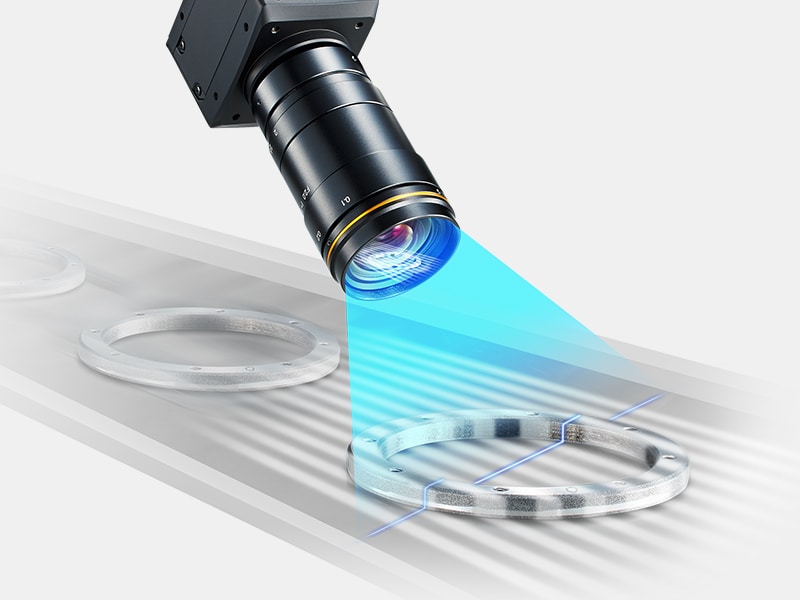
Choosing the right camera technology is an important consideration for machine vision system users. The decision between area scan vs line scan cameras significantly impacts your system's performance, accuracy, and efficiency, but which one is best for your applications?
Key Differences Between Line Scan and Area Scan Cameras
What is a Line Scan Camera?
A line scan camera captures images one line at a time, much like a document scanner. It uses a single row of pixels to build complete images as objects move past the camera or as the camera moves over a stationary object. This sequential scanning approach makes it ideal for continuous processes where objects are in motion.
Line scan cameras excel at inspecting cylindrical products or material in webs. They create images by stitching together individual lines captured in succession, allowing them to handle virtually unlimited image lengths.
What is an Area Scan Camera?
An area scan camera captures complete two-dimensional images in a single exposure, similar to a conventional digital camera. It uses a rectangular sensor array to capture all pixels in the field of view simultaneously. This makes area scan cameras perfect for inspecting parts moving on production lines, or stationary checks.
These cameras take snapshot images of entire scenes at once, making them the go-to choice for most standard machine vision applications where objects can be positioned within the camera's field of view.
Comparison: How Line Scan and Area Scan Cameras Capture Images
The main distinction between area scan vs line scan is how each camera captures images. Think of line scan cameras like document scanners, as they capture one thin line at a time as materials pass by and stitch the lines together to create an image. Area cameras operate similarly to a standard digital camera, taking complete images at once. They are better at capturing entire objects that can fit in a single frame.
Advantages and Limitations of Line Scan Cameras
Consider line scan cameras to be a high-speed photocopier that is constantly tracking a document. As the paper moves along, it captures perfect, distortion-free details inch by inch. While extremely precise, these cameras are not plug-and-play—they are more akin to a specialized tool that requires an expert's touch to set up perfectly.
Advantages and Limitations of Area Scan Cameras
Machine vision area cameras are affordable and easy to use, making them ideal for inspecting discrete objects. They can perform a variety of inspection tasks and capture color images efficiently. However, the area scan cameras have fixed resolution limits, can suffer from motion blur with fast-moving objects, and struggle with continuous surfaces. Inspecting curved surfaces can also be challenging due to perspective distortion.
We’re here to provide you with more details.
Reach out today!

Choosing the Right Camera for Your Vision System
Key Factors to Consider When Choosing a Camera
When choosing between area scan vs line scan cameras, consider several factors. Think about your object's size, shape, and movement characteristics. Evaluate your inspection requirements, including resolution needs and surface details. Consider your production line speed and whether objects move continuously or discretely. Your budget constraints, integration complexity tolerance, and available technical expertise also play important roles in this decision.
When to Choose Line Scan Cameras
Line scan cameras excel in a few key scenarios: examining continuous materials such as webs or rolls, vision inspection of cylinders, capturing oversized objects that do not fit into standard frames, and maintaining clarity on high-speed production lines. They're especially useful for distortion-free imaging of cylindrical surfaces and when you need high resolution in the direction of motion.
When to Choose Area Scan Cameras
Select an area camera for stationary, discrete objects that fit in a single frame. They excel with randomly oriented parts, provide excellent color accuracy, and are simple to set up. They also require less technical expertise to implement, making them suitable for the majority of standard inspection scenarios.
How to Match the Camera with Your Application
The best approach is to carefully analyze area scan vs line scan for your specific application requirements. Consider creating a checklist of your needs regarding object characteristics, inspection goals, production environment, and practical constraints.
Many successful operations employ both technologies for different inspection stages. Working with experienced vision system providers can help determine the optimal camera choice for your unique situation.
Discover more about this product.
Click here to book your demo.

The Role of Line Scan and Area Scan Cameras in Machine Vision
The Impact of Scan Technology on Inspection Speed and Accuracy
Scan technology has a direct impact on inspection results. Line scan works best with fast-moving or continuous materials, maintaining clarity without distortion. Area scan works best for stationary objects and some high speed continuous movement manufacturing lines.
How Both Cameras Enhance Manufacturing and Quality Control
The two camera types reduce defects, ensure product consistency, and enable 100% inspection rates. They also provide valuable data for process improvement and help companies maintain strict regulatory compliance. The right camera choice leads to decreased waste, improved yield, and, ultimately, higher profit margins in production environments.
How KEYENCE Cameras Stand Out in the Industry
KEYENCE Advanced Line Scan and Area Scan Camera Solutions
KEYENCE provides top-tier options for both camera types. Capable of capturing up to 142,800 lines per second, the line scan camera machine vision offers excellent resolution and speed. The area scan models combine ease of use with advanced features such as auto-focus and built-in lighting.
Features That Make KEYENCE Cameras Unique
Built-in processing power is included with KEYENCE cameras, which eliminates the need for external computers. Also, industry-leading image quality and advanced sensor technology are standard. Many models offer a simple plug-and-play setup, which reduces integration challenges.
Integration of KEYENCE Cameras with Vision Systems
KEYENCE designs its cameras for seamless integration into broader vision systems. Our products work with industry-standard interfaces while offering proprietary optimizations for performance. We provide comprehensive system solutions that include lighting, optics, and processing components.
Real-World Success Stories with KEYENCE Cameras
An electrical component manufacturer improved defect detection by inspecting small parts at high speeds with the KEYENCE VS Series vision system and high-resolution area scan cameras. The system's advanced lighting and AI-powered image processing improved accuracy, lowering false rejections and increasing production efficiency. By integrating these cameras, they were able to achieve automated quality control without slowing down operations.
Contact us to learn more about how our advanced technology can help take your business to the next level.
Contact Us
FAQs
What Type of Camera is Best for High-Speed Continuous Scanning Applications?
Line scan cameras are excellent at high-speed imaging, capturing sharp details without motion blur and maintaining consistent resolution across varying object speeds.
Can I Use a Line Scan Camera for 3D Imaging?
Yes, specialized line scan camera machine vision configurations can create 3D profiles. Multiple line sensors or laser triangulation techniques enable height mapping of moving objects with excellent precision.
What Are the Limitations of Area Scan Cameras?
An area scan camera vs line scan has fixed resolution constraints, may experience motion blur with fast-moving objects, and struggles with continuous or very large objects that don't fit in a single frame.
Are KEYENCE Cameras Compatible with All Vision Systems?
KEYENCE cameras support standard industry interfaces for broad compatibility. Their standalone systems work independently, while their component cameras integrate with various third-party systems.
We’re here to provide you with more details.
Reach out today!

Related Downloads
Related Products
Applications
- 2D Measurement Inspection
- Optical Character Reading (OCR) and 1D/2D Code Verification
- Inline 3D Volume and Measurement Inspection
- Presence & Absence Inspection
- Flaw Detection
- 3D Vision-Guided Robotic Bin Picking
- High-Resolution Line Scan Cameras for High-Speed Imaging
- Automated Positioning and Alignment Systems Using Machine Vision
Industries
- Automotive
- Automation Equipment/Machine Building
- Electric Vehicles
- Medical Device Manufacturing
- Food/Beverage Packaging
- Semiconductor/Manufacturing Electronics
- Vision-Guided Robotics
- Solar
- Logistics
- Commodities
- Paper Manufacturing
- Machine Tools
- Electronic Device
- Printing
- Mining/Metals
- Fabric/Textile
- Tobacco
- Marine
- Aerospace

